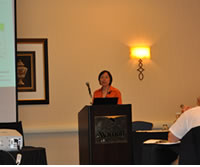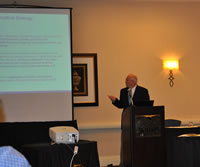Standards were frequently mentioned during yesterday’s solar symposium, held jointly by ASTM International and the Glass Association of North America (GANA).
 Dr. Mei WenFenzi’s Dr. Dino Fenzi, in discussing paint systems for solar mirrors, commented that existing mirror standards don't come close to meeting the durability required for the concentrated solar power (CSP) mirrors installed in the desert, exposed for decades to the elements. “You must forget what has been considered so far to be a benchmark for mirror,” he said. (Click here to read related story.)
Dr. Mei WenFenzi’s Dr. Dino Fenzi, in discussing paint systems for solar mirrors, commented that existing mirror standards don't come close to meeting the durability required for the concentrated solar power (CSP) mirrors installed in the desert, exposed for decades to the elements. “You must forget what has been considered so far to be a benchmark for mirror,” he said. (Click here to read related story.)Jordi Villanueva of Rioglass Solar agreed that parabolic troughs likewise need a standard, perhaps one that makes the use of tempered glass mandatory. And Dr. Mei Wen of Arkema Inc., in describing “TCO-Coated Glass for PV Applications,” stressed that a standardized method is needed to test solar modules that use transparent conductive oxide (TCO) films.
Dr. Chris MooreTCO-coated glass is used as a substrate for thin film PV modules, specifically for amorphous silicone and cadmium telluride (a-Si and CdTe respectively) applications. The TCO coating is very important to increasing the light passing into the cell, Wen explained, but there is no set method for testing the susceptibility of TCO delamination in PV modules or other potential failures. And, as Dr. Chris Moore of Semilab later elaborated, TCO coatings do not consist of a simple, smooth layer, making it difficult to measure, at least consistently throughout the industry. “TCO is layered, roughened,” he said, “however you want to say it, since there's no terminology in the industry for this.” Moore pointed out there are “a bunch of different ways to measure” haze (or the percentage of deflected light), “and they'll give you different results, and some of those results are misleading which is even more difficult.”
However, Moore went on to discuss how the glass industry already is being affected by standards developed by Semiconductor Equipment and Materials International (SEMI). Currently SEMI is working in PV in a large number of areas, Moore said, and a number of these efforts now affect the glass industry - some to be balloted and some already in use. These include standards on topics ranging from the definition of anti-reflective coated glass to what a thin film substrate is supposed to look like – to a proposed test method for haze on TCO films. Already published are standards on glass size and a related guide on light scatter.
“SEMI standards are put in place so suppliers and customers can do the same thing and agree,” Moore said. He noted that the SEMI standard process is open to anyone around the world. And while these standards aren't mandatory, he pointed out good standards can lead to lower manufacturing costs, so people will begin to adopt them.
 Daryl MyersDaryl Myers with the National Renewable Energy Lab (NREL) took the podium to discuss the status of the reintroduction of ASTM E903 on optical properties of materials for PV applications. As Myers explained at last year’s ASTM meeting, the Standard Test Method for Solar Absorptance, Reflectance and Transmittance of Materials using Integrating Spheres essentially “died” in 1996 due to lack of re-balloting. However, Myers says the standard covers properties now important in solar energy systems. Since the last meeting, Myers has led the standard through a comment process and is now working with contributors to resolve negative comments. Myers hopes that these issues will be resolved by August in time for a new ballot.
Daryl MyersDaryl Myers with the National Renewable Energy Lab (NREL) took the podium to discuss the status of the reintroduction of ASTM E903 on optical properties of materials for PV applications. As Myers explained at last year’s ASTM meeting, the Standard Test Method for Solar Absorptance, Reflectance and Transmittance of Materials using Integrating Spheres essentially “died” in 1996 due to lack of re-balloting. However, Myers says the standard covers properties now important in solar energy systems. Since the last meeting, Myers has led the standard through a comment process and is now working with contributors to resolve negative comments. Myers hopes that these issues will be resolved by August in time for a new ballot. GANA technical director Urmilla Sowell closed the session by inviting ASTM members to participate in future activities with GANA’s Energy Division. Even as the session ended, participants were requesting information on next year’s glass-focused symposium.

